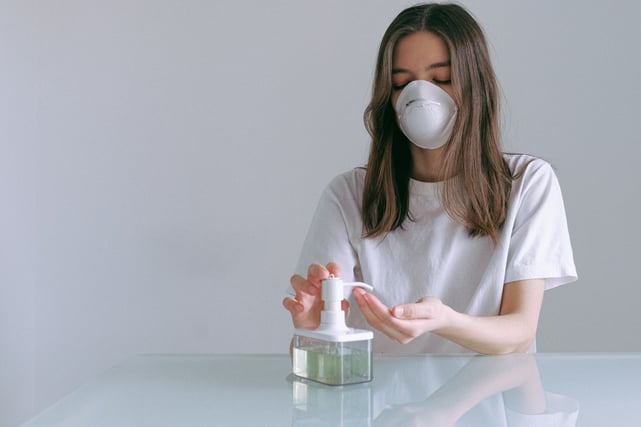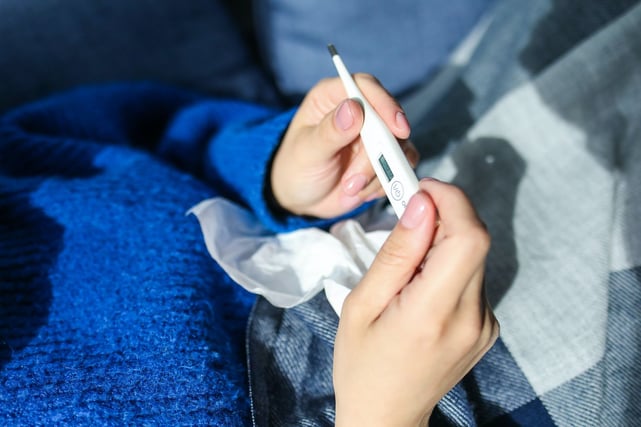With COVID-19 thrown into the mix of viruses floating around, there’s an understandably high level of anxiety surrounding minor symptoms. What could once be brushed off as a minor cold might now require tests, isolation and can cause anxiety (which can bring its own COVID-like symptoms).

So, how might one tell the difference between COVID, the flu, a cold, and anxiety? The good news is that some of these illnesses defining characteristics are different from one another.
After reading this blog, you’ll understand the major symptoms of each illness, the differences between them, and what to do if you’re feeling unwell.
COVID-19 (Omicron Variant)
During previous waves, the new variants of concerns (VoC) carried symptoms similar to the original strain of COVID. Fever, cough, fatigue, etc.. The omicron variant, however, is quite different, both in it's severity and how it presents in symptomatic cases.
Symptoms of COVID-19 Omicron
Symptoms of people infected with coronavirus differs depending on the person. However, the most common symptoms of the omicron variant are:
- Headache
- Sore throat
- Fatigue
- Runny nose
Most importantly, concerning symptoms such as a fever and difficulty breathing are much less common than in any other variant.
Flu

The flu infects the upper and/or lower respiratory tract of the body. Millions of people get it every year, hundreds of thousands are hospitalized and thousands to tens of thousands of people die from flu-related causes each year.
Some people often confuse the flu with a cold. While both are contagious viral infections of the respiratory tract, symptoms are much worse with the flu. Complications from a cold are usually minor whereas those associated with influenza can be life-threatening illness such as pneumonia.
Symptoms
Influenza infection can affect people differently. If you have the flu, you may may experience the following symptoms:
- Fever (for days)
- Chills
- Sore throat
- Cough
- Blocked or runny nose
- Headaches
- Muscle or body aches
- Tiredness
- Weakness
Treatment
Vaccination is the best protection. Though not a guarantee that you be fully protected from the flu, it drastically reduces your chances of contracting the virus, and can help inform your decision about whether you should get tested for COVID.
Many local pharmacies are offering flu shots, and you may be eligible to receive the flu vaccine for free, either through government funding or your employer’s extended health plan or health spending account.
Common Cold

Most people are on the receiving end of the common cold at least once during the winter. It’s quite likely you’ll be feeling unwell for at least a couple days in the coming months—especially if you have kids running around the house.
So how can you tell if it's COVID or a cold?
Common symptoms of the common cold include:
- Runny nose
- Sneezing
- Fatigue
- Cough
- Headache
You might notice that these symptoms are almost identical to the omicron variant. Indeed, part of what makes omicron so transmissible is that people are going about their day with a tickle in their throat, completely unaware that they have COVID. The good news is that common colds are minor and COVID that presents as such are equally minor and easy to treat.
Treatment
We probably all know how to treat a cold: chicken soup, a mildly entertaining show on Netflix, and plenty of rest. Cold symptoms usually begin to recede within a couple days, and you’ll be feeling back to normal within roughly a week.
If symptoms do not get better or get worse, contact your doctor for further advice.
Anxiety

Anxiety covers a large range of causes and symptoms. People with anxiety disorder, such as general anxiety, experience persistent anxiety with occasional panic attacks. Others experience little anxiety in their daily lives, only experiencing symptoms or having panic attacks in extraordinary circumstances.
Regardless, 11% of the population experience panic attacks a year. That’s in a normal year, without a global pandemic and large scale financial uncertainty. Those unfamiliar with panic attacks often report feeling ‘out of control’ and ‘like they’re going die’ during their first one.
For that reason, it’s important to understand what the symptoms of a panic attack are and how to best ride them out, so you can quickly identify and react.
Symptoms
Symptoms of anxiety vary wildly from person to person. However, there are two considerations that can make anxiety unique and tricky to diagnose. The first is that the most common symptoms include:
- Chest pain
- Difficulty Breathing
- Dizziness
All of which are also common with traditional COVID symptoms, but not with omicron. Furthermore, health anxiety can be a chameleon, disguising itself in the symptoms you’re most worried about. In the case of COVID, that means your health-related anxiety is more likely to present itself with chest pain, difficulty breathing, and headaches, as those are symptoms you’re concerned about.
Treatment
Anxiety will typically fade away with time. Panic attacks typically last between 20 to 30 minutes, reaching their peak intensity at around the 10 minute mark. If you’re experiencing a panic attack, it’s recommended that you reduce sensory stimulation. Play calming music (through noise-cancelling headphones if possible) and focus on slowing your breath through deep inhales and exhales.
It’s also important to note that some of the key characteristics of COVID are rarely present in panic attacks. For example: though not impossible, it is extremely uncommon for a panic attack to cause a fever.
Remember that people commonly mistake a panic attack for a health issue, not the other way around. Though if you feel concerned about your symptoms, contact your doctor.
Final Thoughts
As you can see, though there are many similarities between COVID, the flu, a common cold, and anxiety, there are some key differences between them. It is important to take preventative measures to reduce your odds of getting sick, which will in turn lower your overall anxiety.
If you believe you may have COVID, it is recommended you call your community health office and arrange to get tested at a nearby centre.








